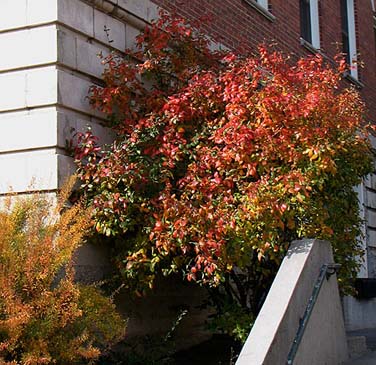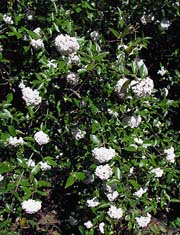Viburnum ×burkwoodii
Burkwood viburnum
 |
 |
Plant form |
Semi-evergreen, spring flowering, upright, multistemmed, woody shrub. |
Size |
8 to 12 feet tall and more than half that wide. |
Leaves and stems |
Dark green leaves are shiny above. Fall color is orange and red. During mild winters, the leaves remain on the shrub. In Pullman and Moscow, most of the leaves fall off during most winters. |
Flowers |
Blooms in spring. Flowers are pleasantly fragrant. The clusters of flowers resemble small snowballs. Flower buds are dark pink and usually open to white. Some cultivars have been selected for redder buds and pink flowers. |
Fruit |
Some plants form sparse clusters of small fruit. They begin red, then turn black in early fall. |
Native area |
This hybrid shrub was created in England in 1924 by crossing Viburnum carlesii (native to Korea) with Viburnum utile (native to China). |
Water use |
Moderate; tolerates some drought. |
Culture and maintenance |
This shrub is easy to grow. It tolerates heavy soils. It can be slow to fill in, so it often looks sparse when it is young. Pruning this shrub after flowering can help this. |
Light |
Full sun or partial shade. |
Hardiness |
USDA Zone 4. |
More photos |
Click here. |
Life is good at WSU.
Secondary content can be almost anything. If you are not using this region delete all the content that is in between the div tags with the id ="additional".
A unique richness of students, faculty, location, activities, and organizations creates a full, lively student life at the University. This section gives you the insider's view on student life and a sampling of the opportunities here.
"Glimpses." Students talk about life at WSU
These brief posts are written by WSU students to give you a personal look through their window on campus life.